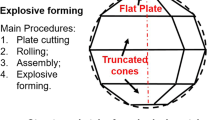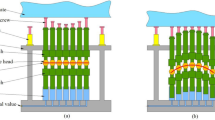Abstract
A continuous cold forming method, named compositing stretch and press bending (CSPB), is an effective process to manufacture a stacer, which is a typical cylinder element with a thin strip for deployable booms in various spacecraft missions. The forming tools in CSPB are a pair of punch and die; a stacer is formed continuously by pulling the strip from the gap between the tools. The process of compositing stretch and press bending is introduced, and the forward bending and the reverse bending occur during this process. The stability of cold forming workpieces has been increased due to those processes above. In this paper, the forming process is analyzed by the numerical simulation and experimental method. The key process parameters such as post tension, die gap, punch radius, and strip thickness are studied. The macromorphology of the stacer formed by CSPB is measured and analyzed. And, the deploying force and the bending stiffness of the stacer under different treatments are investigated. The results show that the simulation results and the experimental results are in good conformity, and a stacer with good forming precision and performance can be obtained by the CSPB process without any other stabilization treatments.
Similar content being viewed by others
References
Ullrich R, McCauley J, Turin P, McKee K, Donokowski B (2008) The STEREO IMPACT boom. Space Sci Rev 136:185–201
Bale SD, Ullrich R, Goetz K et al (2008) The electric antennas for the STEREO/WAVES experiment. Space Sci Rev 136:529–547
Auslander D, Cermenska J, Dalton G et al (2008) Instrument boom mechanisms on the THEMIS satellites; magnetometer, radial wire, and axial booms. Space Sci Rev 141:185–211
Del Llano-Vizcaya L, Rubio-Gonzalez C, Mesmacque G, Banderas-Hernandez A (2007) Stress relief effect on fatigue and relaxation of compression springs. Mater Design 28:1130–1134
Xu LY, Zhu J, Jing HY, Zhao L, Lv XQ, Han YD (2016) Effects of deep cryogenic treatment on the residual stress and mechanical properties of electron-beam-welded Ti–6Al–4V joints. Mat Sci Eng A 673:503–510
Kwofie S (2009) Plasticity model for simulation, description and evaluation of vibratory stress relief. Mat Sci Eng A 516:154–161
Zhang JX, Liu KS, Zhao K, Li XJ, Liu Y, Zhang K (2005) A study on the relief of residual stresses in weldments with explosive treatment. Int J Solids Struct 42:3794–3806
Lawton KM, Lynn KC, Ren D (2007) The measurement of creep of elgiloy springs with a balanced interferometer. Precis Eng 31:325–329
Yan Y, Wang HB, Li Q, Qian B, Mpofu K (2014) Simulation and experimental verification of flexible roll forming of steel sheets. Int J Adv Manuf Technol 72:209–220
Luo YX, Yang WM, Liu ZF, Wang YQ, Du RX (2015) Numerical simulation and experimental study on cyclic multi-point incremental forming process. Int J Adv Manuf Technol 85:1249–1259
Bouffioux C, Pesci R, Boman R, Caillet N, Ponthot JP, Habraken AM (2016) Comparison of residual stresses on long rolled profiles measured by X-ray diffraction, ring core and the sectioning methods and simulated by FE method. Thin Wall Struct 104:126–134
Madariaga A, Esnaola JA, Fernandez E, Arrazola PJ, Garay A, Morel F (2014) Analysis of residual stress and work-hardened profiles on Inconel 718 when face turning with large-nose radius tools. Int J Adv Manuf Technol 71:1587–1598
Jiang XH, Li BZ, Wang LF, Wang ZG, Li HL (2016) An approach to evaluate the effect of cutting force and temperature on the residual stress generation during milling. Int J Adv Manuf Technol 87:2305–2231
Author information
Authors and Affiliations
Corresponding author
Rights and permissions
About this article
Cite this article
Li, Z., Han, J., Yu, C. et al. Numerical and experimental investigation on forming stacer using compositing stretch and press bending process. Int J Adv Manuf Technol 92, 2525–2533 (2017). https://doi.org/10.1007/s00170-017-0340-z
Received:
Accepted:
Published:
Issue Date:
DOI: https://doi.org/10.1007/s00170-017-0340-z




